In the past, automotive electronic systems seldom used capacitive sensors because they were considered difficult to control, difficult to read, prone to ageing, and susceptible to temperature. Capacitive sensors, on the other hand, have attractive features such as moderate manufacturing costs, simple form factor, and low power consumption, which powers their use. With the advent of new measurement technologies, the number of capacitive sensors used in automobiles has increased dramatically.
This article refers to the address: http://
challenge
Macroscopically, to analyze a capacitive sensor, it is usually necessary to convert its capacitance to another physical variable such as voltage, time or frequency. Microscopically, capacitive sensors have been used in automobiles for a long time. Microelectromechanical acceleration sensors are based on this principle. These sensors are often used to detect charge transfer.
A new method for detecting capacitance is to use an adapted sigma-delta converter input stage to detect unknown capacitance and convert it to a digital value. This article will describe this approach to using capacitive-to-digital converters (CDCs) and several capacitive sensor principles that can be used in automotive electronics design. Finally, this article outlines another alternative.
Capacitance to digital converter
In order to visualize the CDC method, we must first understand the principle of Σ-Δ conversion. Below is a simplified sigma-delta converter circuit diagram.
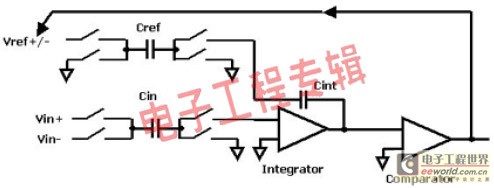
In order to clearly understand how it works, we first look at the input of the integrator, which must maintain a zero value over a longer time interval, and small short jumps will be converted to ramps. The zero mean can be achieved by raising the output of the reference branch to the same level as the input branch, which in turn is affected by the output of the comparator. At logic 1, the reference voltage is switched to the subsequent capacitor.
The capacitor is reversely charged and applied to the integrator, causing a negative reference voltage to be applied to the integrator. The high voltage at the input thus causes a large amount of logic 1, which in turn acts frequently on the negative reference voltage. The density of 1 is converted to a digital value by a post digital filter. A typical sigma-delta converter compares the unknown voltage to a known voltage and does so using two known (usually equal) capacitors.
In fact, the charge is compared, so if both voltages are of a known value (in this case an equal voltage is used), the capacitance can be compared by Q=C*V. A synchronous voltage signal must also be applied to the input branch as shown in the capacitance to digital converter shown below.
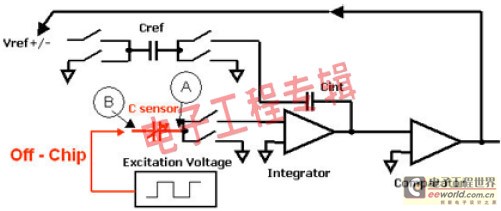
This method has several advantages. Because of their close relationship with sigma-delta converters, their well-known characteristics can be modified and employed, including: high noise rejection, high resolution at relatively low frequencies, and the ability to achieve high accuracy cost-effectively.
All sigma-delta converters have similar input structures, almost without exception, so that special structures can be modified to suit specific measurement tasks, such as: extremely low current input, highest precision or higher. Cut-off frequency.
If we look closely at the above picture, we can find more advantages. The parasitic capacitance has no effect on the initial approximation. The parasitic capacitance that leads to zero at node A has a zero potential. Node B is not at zero potential, but a defined low-impedance potential is fed into it, so the parasitic capacitance at that node will be charged to an average value that does not affect the measurement. The parasitic capacitance from node A to node B is always in parallel with the measurement unit and always appears as an offset.
Existing capacitance to digital converters can provide very high performance. For example, Analog Devices' AD7745 achieves 24-bit resolution and 16-bit accuracy.
Capacitive sensor
In the past, capacitance analysis systems required relatively large measurement capacitances and large capacitance changes when touched. Requiring large enough changes often causes problems for sensor manufacturers, and smaller capacitive sensors do not. For example, a typical 150 pF humidity sensor is not only very expensive (because it has a large capacitance), but is also more prone to errors and has a lower long-term stability.
The capacitance of a capacitor can be calculated based on its structure:
C = εoεr A/d
Where εo is the dielectric constant of free space, εr is the dielectric constant of the material, A is the area of ​​the available metal plate, and d is the distance between the two electrodes. With a few exceptions, such as pressure sensors, all other capacitive sensors measure the change in capacitance using changes in the surface of the metal plate or dielectric. Most sensors can be divided into two categories: one is the change in the geometrical area of ​​the metal plate, such as liquid level sensing or displacement sensor; the other is the change in the dielectric constant εr of the material, such as proximity sensor or humidity sensor.
Dielectric sensor
A typical example of a dielectric sensor is a moisture sensitive sensor that uses a moisture sensitive polymer layer as a dielectric. As the humidity increases, more and more water molecules deposit, resulting in an increase in εr. Sensors that determine the purity of a liquid, such as petroleum or fuel, are essentially composed of two fixed plates that themselves constitute a dielectric. The required liquid properties are determined empirically (ie, the moisture in the oil or fuel increases). Temperature plays a decisive role and must be reliably determined. Simple proximity sensors that determine dielectric changes often require the most sophisticated measurement electronics.
In most cases, the proximity sensor consists of two conductors on a printed circuit board with a very low dielectric constant (close to 1). If an object (such as a hand) moves into the electric field of the capacitor, the capacitance changes. The human body has a water content of more than 90% and therefore has a very high dielectric constant (about 50).
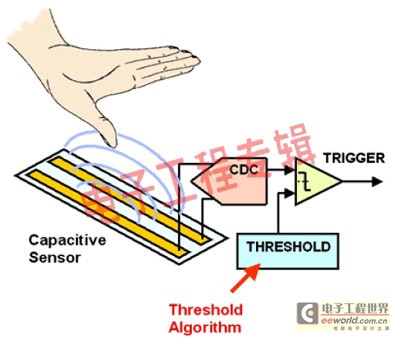
Non-contact switches are very easy to manufacture and support applications such as keyless ignition or power window anti-pinch. The core requirement of a keyless car is that the current input is as low as possible and the standard value is less than 100 uA. The sigma-delta converter has been optimized for many years in the industry, so it provides the right architecture.
Rain sensors can also be implemented in a similar way, are easy to produce and cost effective, and have the advantage of form factor. However, the traditional rain sensor based on optical refraction of water droplets has a very small effective area on the windshield glass, which reduces the sensitivity of the system and repeatedly causes problems with dry scraping and wiper failure.
Geometrically variable sensor
Examples of sensors that rely on geometric dimensional changes are pressure sensors, level sensors, and displacement sensors, all of which simply move the dielectric between the fixed plates. The pressure sensor uses two fixed-size plates as the diaphragm. When pressure is applied to the sensor, the distance between the plates changes due to elasticity.
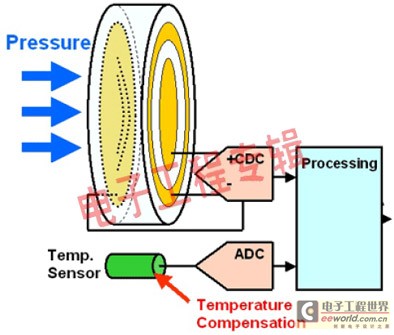
Due to thermal expansion, a temperature sensor is needed to measure the change in geometry. It is envisaged that one electrode is connected to the chip and the other electrode is connected to a casing made of metal or ceramic, so that the casing itself functions as a sensor. For example, ceramic housings can withstand very high pressures and aggressive media. Compared to traditional Wheatstone bridges, the main advantage of capacitive pressure sensors is their lower input current requirements, making them ideal for applications such as tire pressure control.
In the level sensor, a pair of fixed plates are immersed in the liquid to be tested. Manufacturers are able to implement printed conductors at very low cost. The second pair of plates are mounted in the bottom area to detect changes in the dielectric due to temperature or other effects, as shown in the following figure.
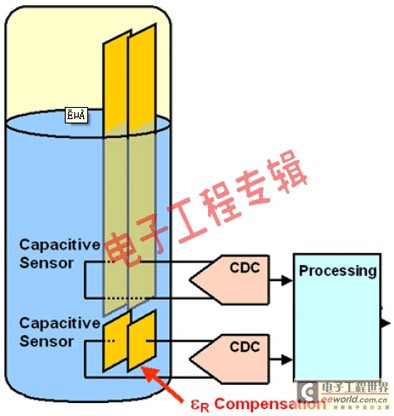
Among all methods, the Σ-Δ technique proved to be exceptionally effective. In many cases, digital filters that must be used can be used to achieve the desired dynamic behavior. For example, liquid level sensors require an extremely long time constant, while proximity sensors must adapt to changing environmental conditions (such as humidity sensors used to measure rainfall or icing).
Another alternative
There is also a technique that works in a completely different and slightly more complicated way. However, it can be used to measure complex impedances, including inductive, resistive/capacitive or resistive/inductive sensors. In this case, the sensor is excited by a very accurate known frequency, and direct digital synthesizer (DDS) technology is well suited for this application.
Calculate the real and imaginary parts of the impedance using the DDS method
Analysis of the response of the sensor recorded by flash analog to digital converter and fast Fourier. With the DDS method, the original phase position can be accurately known at any time. In the same way, the response to other frequencies can also be measured. From this it is possible to calculate the real and imaginary parts of the impedance and then output them via the digital bus. A full scan is only a few hundred milliseconds. The figure below illustrates the method.

The network analyzer circuit can be used for capacitive and inductive sensors, as well as sensors that record motion or measure the viscosity of liquids such as oil or transmission oil.
Conclusion
Capacitive sensors are reborn in automotive applications, and new applications have emerged in applications such as pressure, level, humidity, rainfall and proximity sensors. Σ-Δ technology provides a flexible solution to meet different dynamic and accuracy requirements, and supports sensor systems that require extremely low power requirements. CDC devices have been used in a variety of automotive applications and will be used in a wider range of applications.
Low temperature lithium battery refers to the working temperature under - 20 ℃,to meet different environment and temperature. YFJ company has designed a lot of this kind of Low Temperature Battery with our own advantages.
1.Dual IC chips, that can anti-shortcircuit, anti-overcharger, anti-overcurrent, anti-overload
2.Widely using temperature range, lower temperature Lithium Battery can be operated in -50°C~+60°C
3.Long
cycle life, more than 500 charge/discharge cycles (0.2C)( 80% capacity remained
). more than 800 times(0.1C charge/discharge
4.The Battery Pack has a high cycle life, which conforms
to the values of low carbon, energy saving and environmental protection
Low Temperature Lithium Battery
Items specification
Charge voltage: 16.8V
Nominal voltage: 14.8V (4S4P)
Initial impedance: 200mΩ
Nominal capacity: 10Ah
Minimum capacity: 9.8Ah
Low-temperature capacity : ≥7.0Ah When the battery is standard charged, it shall be put into chamber at ( -40±2 )℃ for 8-16hrs,then discharged at 0.2C(2A) constant current to10.0V.
Charge current : Standard Charging::0.2C5A (2A)
Rapid charge:1.0C5A C(10A) Max
Charging time : Standard Charging:6.5hours(Ref.)
Rapid charge: 2.5hours(Ref.)
Max.discharge current : 10A(1C5A)
Discharge cut-off voltage : 10.0V
Shelf life : 2 years
Cycle life (0.2C5A/0.2C5A) : 500 times,≧80%DOD; 500 times, ≧80%DOD
Operating temperature : Charging: 0℃~45℃ Discharging:-40℃~+60℃
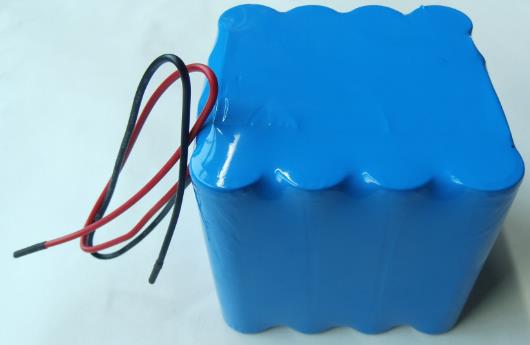
Low Temperature Lithium Battery
Low Temperature Lithium Battery,Low Temperature Battery,Low Temperature Lithium Ion Battery,Low Temperature Rechargeable Battery
YFJ TECHNOLOGY (HK) CO.,LIMITED , http://www.yfjpower.com
